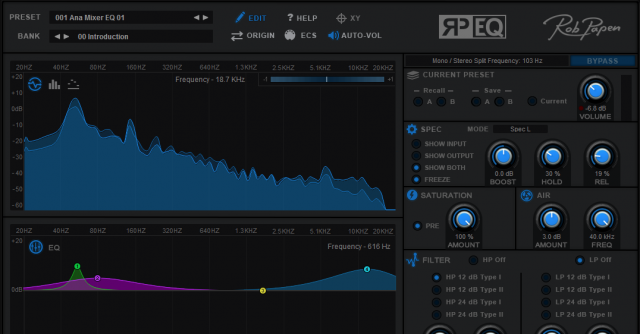
Rob Papen has introduced RP-EQ, a new EQ effect that he says “is far from a basic bread-and-butter equalizer”.
Here’s what Papen has to say about it:
Unique elements were added to the core equalizer unit.
The toolbox includes a Mid/Side equalizer mode and Mono/Stereo split filter which is used frequently in modern EDM/Dance music styles. The Air section is fantastic on your master channel and the proven X/Y Pad adds a dynamic and creative edge to an already very musical RP-EQ.
Here’s the official video intro:
Features:
- Presets & Banks
Several banks with presets, selectable in the upper screen section - Current Presets A /B
A Preset in RP-EQ has two slots, A and B, to store two variations of the Preset. The A and B variations are useful to compare different versions while you are editing. Thecurrent, live, settings can be recalled at any time via the Current button
-
Volume
Volume control with in the uppers section the ‘on/off’ option for ‘volume correction’ if volume goes over 0dB. Bypass button to hear the difference between the ‘original’ signal and ‘RP-EQ’ signal. - Spectogram
The RP-EQ spectrogram displays the input and output signal as an FFT Spectrogram, a 30 band (1/3 octave) Bar Spectrogram or a 30 band (1/3 octave) Single line Spectrogram. The icons on the left hand side of the Spectrogram display switch the display mode between FFT Spectrogram, Bar Spectrogram and the Single Line Spectrogram. Controls for ‘Hold’ and ‘Release’ of the peak lines in Bar mode. Control of ‘Release’ in the Single Line mode. Display mode of: Left, Right, Stereo or Mid/Side Additional ‘gain’ boost control.
-
EQ
8 band EQ which can work in normal mode or Mid/Side mode.
In Mid/Side mode, the Bands 1-4 are for the ‘Mid’ signal and Bands 5-8 for the ‘Side’ signal. Graphic control panel and lower control panel with additional setting options for view , solo or lock a single band. - Saturation
The Saturation section applies a warming effect to the sound, based on the effect of saturated analogue tape recordings.
- AIR
The Air section represents an additional EQ band, which works as a booster of very high frequencies with a wide bandwidth. Its effect is perceived as giving the audio a bit more breathing space or Air.
- Filter
A typical application of this filter section is to use the HP filter with a setting of 75 Hz to filter out any rumble or otherwise uncontrolled low-end material. The slope of thefilters is selectable between 12 dB and 24 dB per octave and each filter comes in two filter types. A LP filter is a classic ingredient of any synthesizer set-up and we have added one in RP-EQ to enhance the creative application of equalisation. In combination with the XY pad, the Filter section is the place to start for dynamic and rhythmic filter effects.
-
Stereo/Mono Split Filter
The Mono / Stereo Split Filter is able to divide the audio signal in a mono and stereo part based on a frequency. Typically, low frequencies do not contain much spatial information and are perceived as mono signals. Spatial placement in a stereo image is provided by the higher frequencies. The Split Filter is a great tool for contemporary music in a mix-bus configuration or for mastering. The signal post the Split Filter consists of two parts that can be processed separately: a lower frequency mono component and a higher frequency stereo component. -
XY section
The XY Screen works as two programmable LFOs. Movement in each direction directly controls the value of one or more RP-EQ parameters. XY basics – Live / Record / Replay In Live mode you move the blue dot manually across the XY pad (use the mouse to click and drag). The position of the mouse and your dragging skills determine the X and Y value. You can also record movements on the XY pad as paths. Switch XY to Rec mod and draw a path. For as long as you keep the mouse button pressed, RP–EQ will capture all movements as a path in its memory. After recording, the path is ready for playback. Switch to Replay mode, and play a note. You will see the XY indicator move across the screen according to previously recorded path. The path is saved as part of the Preset, and is ready to go when you recall the Preset. Instead of playing a note to trigger the path playback, the path can also be made to run freely, or triggered manually by clicking the button adjacent to the mode Switch.
Rob Papen RP-EQ is available for EUR 79 | USD 89. See the Rob Papen site for details.

I don’t need another EQ, but having purchased a few Rob Papen plugins in the last year i now trust him; he only puts out creative quality products with interesting twists. Good work.
Yeah, quality stuff from Rob Papen is quite routinary, gratefully